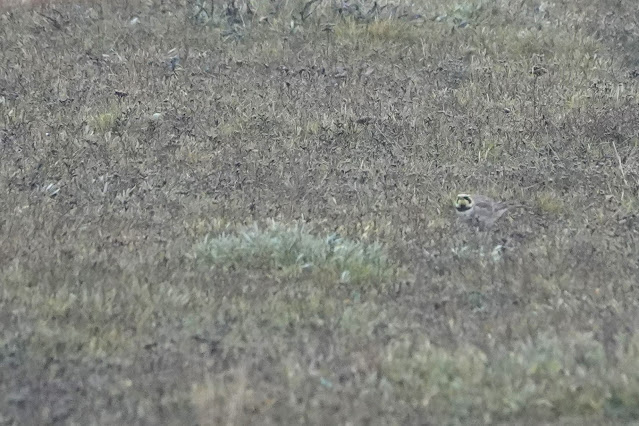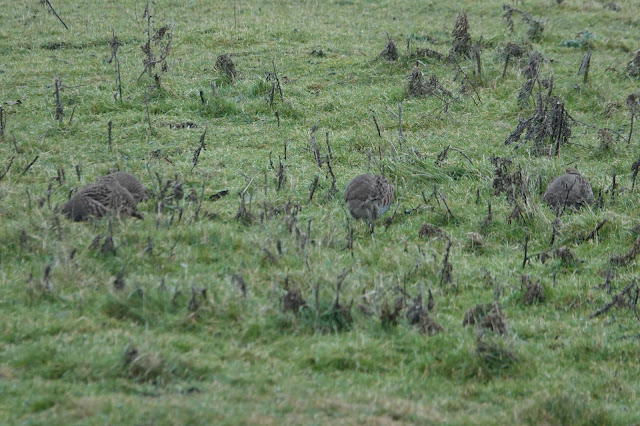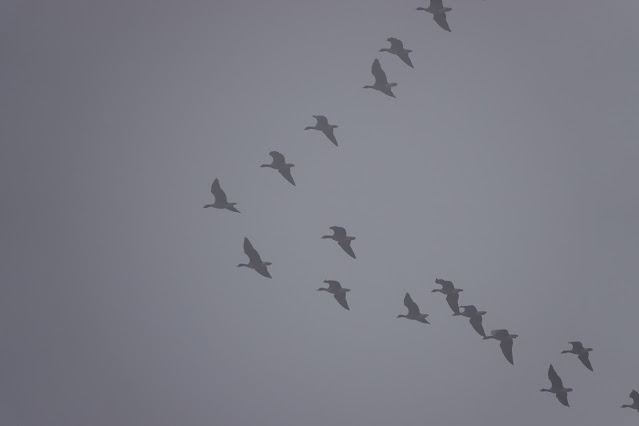As my day out in Kent had no takers by Monday, Pat decided that I should be taken out for the day (subsequently sorry Sally!) and so I met him at his abode in Woodford at 6am yesterday for a North Norfolk excursion. The weather driving up was dire with almost freezing fog all of the way and we thankful to arrive at Holkham being able to see the trees in the distance!
With the slow journey up we were a little late for the full
goose spectacle but there were still hundreds of Pinkfeet heading east and inland from the
direction of Wells. A vast flock of
Wigeon were grazing alongside Lady Ann’s Drive and Snipe were foraging in the
wet meadows and actually approaching quite close to where we parked where the
would duck down in the grass at the slightest suggestion of trouble which was frequently
provided by the marauding Red Kites and Marsh Harriers.
Pinkfeet Could-be-any-colour-feet Legless Snipe
It was a monochrome landscape and even the Great White
Egret that lumbered over the road barely cut through the gloom with its usual
gleaming brilliance.
 |
| Grim White Egret |
We geared up with as many layers as possible and headed
through the Gap to the beach passing Goldcrests and Coal Tits in the pines on
the way. The tide was still well in and
an elevated scan only produced a few Black-tailed Godwits, a single Brent Goose
and a couple of Redshank so we followed the Bay east towards the ‘compound’
where the Shorelarks are regularly to be found.
There were Rock and Meadow Pipits, Skylarks and a small Linnet flock on
the saltings and it did not take long to find the three little yellow lark
faces grovelling in the sandy areas. It
has been a while since I have seen this delightful species.
 |
| Notsurelark |
We left a tour group watching them and headed for the sea where
the dunes afforded some shelter from the chilling breeze that had got up. The sea was calm but almost devoid of birds
despite visibility up to about half a mile out.
A dozen spiky headed Mergansers were found along with a single
Red-throated Diver and a just one Grebe but to our delight it was a dusky
fronted Red-necked. Sanderling scurried
along the foreshore like clockwork automatons and Oystercatcher and Grey Plover
were also seen.
Retracing our steps around the Bay saw us bump into another
party of Shorelarks on the east side. We
had been told there were seven but 13 were counted on several occasions. These ones showed even better as they shuffled
on almost invisible legs. We had
collected six other people (none of whom had seen the species before) and by
standing still we all got some memorable views.
Every now and then they would take off with the Skylarks and Linnets but
would separate off and the thin calls could clearly be heard. They would soon return to roughly the same
spot and recommence stocking up on seeds.
 |
| Shorelarks |
 |
| Shorelarks - five in this shot! |
The sea beckoned again but had receded some way so our impromptu
party walked most of the way down. It
looked busier but closer inspection revealed that the duck rafts were not
Scoter but Wigeon and Teal! In fact I only
saw one female Scoter! There were other
birds through with about another dozen Mergansers, a first-winter male Eider,
Red-throated Diver, two Great Crested Grebes and surprisingly two more
Red-necked Grebes. Of the Snow Buntings
there was no sign.
 |
| There had been some beach galloping |
Walking straight back at the pines took us to the hide but
the freshmarsh was scarily devoid of birds.
I had read tweets from two weeks ago off 13000 Lapwing along with vast
numbers of wildfowl. We saw three
Lapwings and a few Greylags and Egyptian Geese and even the 200 Russian
White-fronts were not visible so we ambled back passing a fine Red Kite with a
fresh Rabbit kill and several more Marsh Harriers and Buzzards but not the
hoped for White-tailed Eagle which had buggered off to the Broads.
There were very few small birds in the wood with only Treecreeper
of note although the Firecrest was calling in the huge Holm Oak by the visitors
centre and Pat actually had a good view in my absence. Six Grey Partridge were in their regular spot
in the corner of the first field and the same raptor selection were still
giving the wildfowl serious grief out on the marsh towards Wells. There was still very little light and I was dithering
about what to do so we went west and had a look out over the freshmarsh from
the Burnham layby. There was almost
nothing at all bar the raptor trio again, a Great White Egret and some
Red-legged Partridges. There were no
Brents or Pinkfeet let along the hoped for Russian White-fronts. Fortunately a brief stop at one of the
Holkham gates gave us 20 of the latter complete with belly bars and facial
blazes.
 |
| Vaguely Reddish Kite |
 |
| Wigeon |
 |
| Very-Grey Partridges of the headless subspecies |
 |
| Red-legged Partridges |
East again to Cley (ignoring some strange ‘road closed’ signage) and parking up at the East Bank in light rain. The Serpentine was frozen with a film of water on top but there were only Wigeon in the fields and not waders at all as we walked down while Arnolds Marsh added Avocet, Little Egret and Pintail to the day tally but there were only five Black-tailed Godwits and no sign of the Dowitcher.
The rain was light but painfully icy and a few minutes at the sea
produced a single Great Crested Grebe and not one other bird. It was all getting a little dispiriting but
thankfully a blizzard of Snow Buntings warmed our hearts as they drifted around
us in a flock of rippling, flickering black, white and brown. The disappeared almost completely into the
shingle and we were able to scan them for the Lapland Bunting but a Goldfinch
was the only waif amongst them. My pictures
tell me that there were at least 72 so my use of the word blizzard was appropriate
for the first time in many years.
 |
| Snow Buntings - 23 in this pic and the Goldfinch |
 |
| Snow Buntings |
 |
| Snow Buntings |
The rain was getting heavier so we about turned and trudged
back with a lovely Kingfisher and ice skating Water Rail for our troubles. I am not sure I have experienced such a grey
bitterly cold colourless day before.
Garden Drove to wait for the Pallid Harrier had been the intention but the idea of walking down the muddy track, standing around and then trying to walk back in the near dark really did not appeal so we opted for the lazy option of Stiffkey campsite car park which at least meant we could retreat if the heavens opened and we spent the next 90 minutes scanning the murky saltmarsh and distance sandflats. We did quite well all things considered with a female Hen Harrier close over the marsh heading west, two Marsh Harriers, Red Kite, female Merlin and distant female Peregrine along with a ghostly Barn Owl.
The Pallid may well have snuck by us but it was
hard work and tough on the eyes in such poor light. Little Egrets were dotted across the area and
seemed in no hurry to head off to roost while out on the sandflats skein after
skein of Pinkfeet dropped in and settled down for the night. This is the first time I have ever seen them
do this and despite the great range you could still hear them ‘winking’ while a
good mile to the west the Dark-bellied Brent geese were massing similarly and were
noisily grumbling. There were parties of
these all around too and you could see the white bums winking on and off as
they waddled around.
A Roe Deer appeared way out on the sand and ran like a demented dog through the entire flock of Pinkfeet which quickly settled after it popped out the other end. Quite what it was doing way out there is anyone's guess. Three Muntjac popped up under our noses too as they worked their way through the Sueda.
Curlews drifted back from the inland field where they had
been feeding and were very vocal and a Song Thrush started singing behind us as
the day came to a close but sunset came and
went with no visible change in the light quality and it was the lack of feeling
in fingers and toes than finally persuaded us to call it a day before similarly
wet and grim journey home.









No comments:
Post a Comment